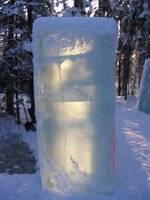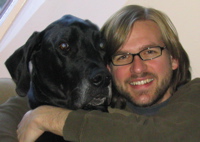Our design required quite a few large, precise holes to be bored through pieces of ice. Some of the holes were to accommodate freely turning axles, some were to be bonded to axles, but all needed to be perfectly perpendicular. The best way to bore perpendicular holes is with a drill press, but many of the holes, such as those in the middle of large gears, required a drill press with an incredibly deep throat. Thus was Lars's mobile drill press idea born.
He removed his drill press from its stock pedestal and mounted it on a custom carriage assembly above a steel table. This allowed us to position the drill over any part of a large slab of ice. While the concept was brilliant, the hurried construction resulted in critical failures that impaired our ability to bore truly perpendicular holes.
First, a weld broke on one side of the carriage, most likely because of the quality of the scrap steel it had been made from. The drill press could still be positioned and operated, but the drill pulled away from the carriage every time the bit was pressed into the ice.
Second, the carriage rails rested on top of vertical pins at the edges of the table but were not firmly attached to the pins. Even when holding the broken weld together, this allowed the entire carriage assembly to come out of alignment under pressure.
Third, even if we had solved the first two problems, there was no easy way to set up the carriage such that perpendicularity of the drill bit with respect to the table could be assured. We would have had to first level the table (not a simple task on hard packed snow) and then carefully adjust all four pins to level the bit. If we had ever changed the height of the rails, we would have had to readjust all of the pins.
The mobile drill press also had trouble with vertical travel. We weren't able to drill deep enough below the carriage rails, but we probably could have corrected this by shortening the pipe supporting the drill and/or using bit extensions. The total travel of the drill press was about three inches, but a few of the parts to be drilled were four or six inches thick. We figured that we could flip parts over and drill them from both sides, but we hadn't prepared any kind of centering jig to ensure correct alignment of opposing holes.
All in all, the mobile drill press turned out not to provide any benefit over a hand drill, but the original idea still has great potential. With several months to come up with a better solution, I'm sure that next year's model will be much improved.



























